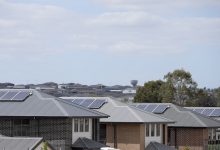Australia’s rooftop solar market has shown no signs of slowing down so far in 2020, despite a start to the year marred by the coronavirus pandemic and an economic downturn that is hitting global energy markets as hard as any other.
The latest data from leading Australian solar industry statistician SunWiz finds that while the registration of large-scale generation certificates for big solar projects heads in the opposite direction, registration for small-scale solar systems (0-100kW) – the vast majority of them for residential rooftop solar – remains on the up and up.
SunWiz says steep growth in small-scale PV installations over the course of February has broken all previous records by notching up the highest monthly registered capacity of 218MW.
On a state-by-state basis, the month also delivered records for Victoria (48MW), South Australia (24MW) and Western Australia (26.5MW), while New South Wales got back on track and registered 59MW, just shy of its own monthly record.
Queensland also got back on track, adding a total of 53MW of solar systems between 0-100kW and is tracking ahead by 34 per cent compared to the last year.
“The residential market showed an exceptional growth, particularly in 6-8 kW segment,” said SunWiz managing director Wawrick Johnston in his monthly report, noting that the small commercial market had also shown “noticeable growth.”
“In the overall distribution, the residential sector has grown overall. After last months fall back in most of the states, this month all states showed a promising growth. NSW retained its #1 position, followed by QLD and VIC. VIC, SA and WA all had record months,” Johnston said.
All up, he said, the market has stayed significantly ahead of the last year with 34 per cent growth (see chart below).
On a state-by-state basis, the report notes that New South Wales is ahead by 46 per cent on installs, compared to last year, albeit with a fall-back across all segments of the commercial solar market, except 75-100kW.
Queensland had a steady February, Johnston says, after last month’s “drastic reduction in commercial segment;” South Australia, meanwhile, “bounced back exceptionally well and registered its own all-time highest capacity,” as noted above (and see chart below). SA is ahead by 41% compared to the last year.
 Victoria, with the aid of its state government rebate scheme, continued growth at the same rate and achieved its own all-time highest monthly registered capacity to put it 16 per cent ahead of last year in terms of capacity – a number perhaps dented by a huge fall back in the commercial 75-100kW segment, the report notes.
Victoria, with the aid of its state government rebate scheme, continued growth at the same rate and achieved its own all-time highest monthly registered capacity to put it 16 per cent ahead of last year in terms of capacity – a number perhaps dented by a huge fall back in the commercial 75-100kW segment, the report notes.
For Western Australia, the stand-out was “exceptional growth” in its commercial sector, thanks to “tremendous growth” in its own 75-100 kW segment.
The other states – Tasmania, the NT and the ACT – also got back on track and registered about 8 MW, which is quite close their highest record, Johnston says.
Across the board, the average rooftop system size eased back a bit to 7.7 kW/system.
Meanwhile, in the large-scale sector, the below SunWiz chart shows that after hitting a new high in November, the number of accredited solar LGC projects continued to drop in the second month of the year as well. This is likely to be at least partly due to the well-documented delays in getting projects connected to the grid, which it turn is thanks to network congestion and uncertainty around market rules.
The small solar sector may not be immune to the troubles of the market, either – least of all coronavirus, which may yet hit PV panel supplies in Australia after the weeks of plant shutdowns in China in the first months of the year.
But for now, the boom continues.
To read the original story on RenewEconomy sister site, One Step Off The Grid, click here…











